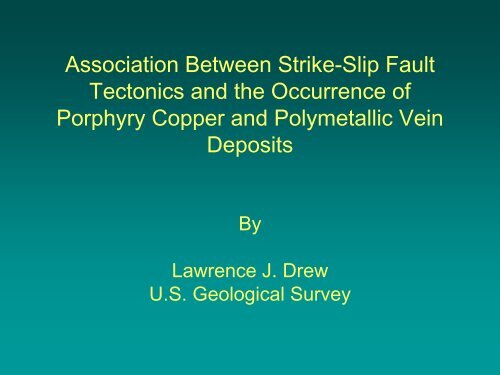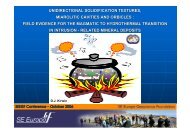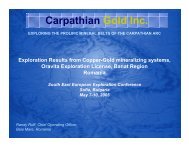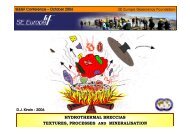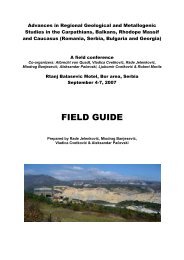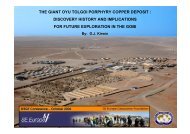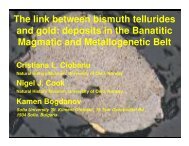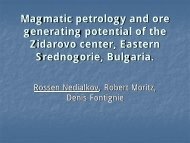Association Between Strike-Slip Fault Tectonics and ... - Cmi Capital
Association Between Strike-Slip Fault Tectonics and ... - Cmi Capital
Association Between Strike-Slip Fault Tectonics and ... - Cmi Capital
Create successful ePaper yourself
Turn your PDF publications into a flip-book with our unique Google optimized e-Paper software.
<strong>Association</strong> <strong>Between</strong> <strong>Strike</strong>-<strong>Slip</strong> <strong>Fault</strong><br />
<strong>Tectonics</strong> <strong>and</strong> the Occurrence of<br />
Porphyry Copper <strong>and</strong> Polymetallic Vein<br />
Deposits<br />
By<br />
Lawrence J. Drew<br />
U.S. Geological Survey
BEGININGS<br />
• In the 1970s, 1980s, <strong>and</strong> early 1990s, the<br />
U.S. Geological Survey (USGS) undertook<br />
the assessment of undiscovered mineral<br />
resources in:<br />
• 1. Proposed wilderness areas<br />
• 2. Natural forests<br />
• 3. Public l<strong>and</strong>s<br />
•4. USA
Recently<br />
• Individual countries<br />
• Globally for several types of mineral<br />
deposits
Proposed Wilderness Areas in<br />
1983
Many Deposit Types<br />
But<br />
Porphyry Copper Deposits<br />
Were Very Important
Observation<br />
Porphyry copper <strong>and</strong> associated deposits<br />
such as polymetallic veins, skarns,<br />
replacement deposits, are very important<br />
in the assessment of undiscovered<br />
minerals.
Titley’s Model
Apuseni Mountains, Romania<br />
(Borcos, 1962)
Northern Hungary<br />
(MAFI-USGS 1995-1998 study)
Mátra Mountains, Hungary<br />
(MAFI-USGS 1995-1998 study)
Mátra Mountains
Mátra Mountains
Apuseni Mountains
Observations<br />
(Seraphim <strong>and</strong> Hollister, 1976)<br />
Mineralized porphyry stocks are:<br />
• Small <strong>and</strong> nearly cylindrical in shape<br />
• Cross-section, approximately 1 square kilometer<br />
• Often near-surface emplacement<br />
• Possible extreme vertical extents, up to 7 kilometers<br />
• Co-eval strike-slip system nearby
A Model for Earthquake Swarms in<br />
Volcanic Regions<br />
(Hill, 1977)<br />
• Clusters of magma-filled dikes exist in the<br />
crust.<br />
• These dikes are oriented according to the<br />
greatest regional principal stress.<br />
• The tips of the dikes are connected to<br />
each other by shear faults.
Earthquake Swarm--Continued<br />
• The dike swarms are closely associated<br />
with strike-slip faults.<br />
• Volcanism <strong>and</strong> igneous intrusions are<br />
closely associated.
Hill’s Extensional-Shear Mesh
Adaptation to Mineral Deposits<br />
(Sibson, 1985)<br />
• Dilatational jogs (fault duplexes) in strike-slip<br />
fault systems are common host of<br />
mineralization.<br />
• <strong>Fault</strong> duplexes are vertical conduits for<br />
hydrothermal fluid flow.<br />
• Earthquakes trigger the flow. Deposition is<br />
episodic.
Sibson’s Extensional-Shear Mesh
The Mesh Is a Common Ore Host<br />
Chuquicamata, Chile<br />
Martha Lode, New Zeal<strong>and</strong><br />
Sibson, 1985
Synthesis Using Laboratory<br />
Model Studies<br />
• Segall <strong>and</strong> Pollard (1980)<br />
• Connolly <strong>and</strong> Cosgrove (1999)
Segall <strong>and</strong> Pollard
Connolly <strong>and</strong> Cosgrove<br />
(1999)
The Classical Magmatic-Hydrothermal<br />
Model for Porphyry Copper Deposits<br />
after Burnham, 1979
A Porphyry Deposit<br />
• It is created in a reaction containment<br />
vessel that produces a large volume of<br />
silica that forms a carapace that is<br />
repeatedly fractured.<br />
• A “quiet” extensional environment (little or<br />
no shear) is a basis requirement.
The Sequence of Deposition<br />
• Far-field stress nullified locally—<br />
porphyry copper emplacement<br />
• Far-field stress reestablished —<br />
acid sulfate veins followed by<br />
quartz adularia veins
Location of fault duplexes where porphyry<br />
copper <strong>and</strong> polymetallic vein deposits may<br />
occur in an orogen<br />
Members of the porphyry<br />
copper <strong>and</strong> polymetallic vein<br />
family of deposits occur in close<br />
spatial <strong>and</strong> temporal<br />
association with strike-slip fault<br />
duplexes.<br />
Location of strike-slip<br />
duplex structures along an<br />
active tectonic-plate<br />
margin (modified from<br />
Bally <strong>and</strong> Oldow, 1985).
The Structure of Oblique Subduction<br />
Systems<br />
(de Saint Blanquat <strong>and</strong> others, 1998)
Central Europe<br />
• Application of a tectonic model for the spatial occurrence of<br />
porphyry copper <strong>and</strong> polymetallic vein deposits.<br />
• Cretaceous deposits in the Srednogorie-Timok<br />
Timok-Banat<br />
region<br />
in Bulgaria, Serbia, <strong>and</strong> Romania.<br />
• Miocene deposits in the Apuseni Mountains, Romania, <strong>and</strong> in<br />
the central Slovakian volcanic field, Slovakia.
Location of <strong>and</strong> Application of the Tectonic<br />
Occurrence Model to the Late Cretaceous<br />
Porphyry Copper Deposits of Central<br />
Europe
Tectonic Reconstruction<br />
(Csontos <strong>and</strong> Nagymarosy, 1998)
“Straightening” Out the Orogen<br />
(Willingshoper, 2000; Ciobanu <strong>and</strong> others, 2002)
Cretaceous Age Porphyry Copper<br />
Deposits in Central Europe<br />
(modified from Singer <strong>and</strong> others, 2002)
Satellite Images Used as a Basis for<br />
Compilation in the Srednogorie Region
Locations of Deposits <strong>and</strong> <strong>Strike</strong>-<strong>Slip</strong><br />
<strong>Fault</strong>s
Registration of Geology<br />
(modified from Geografski Institute of Bulgaria, 1973; Bogaonov, 1983;<br />
Bayraktarov, 1994; Strashimirov <strong>and</strong> others, 2002)
Registration of <strong>Fault</strong>s<br />
(Modified from Geografski Institute of Bulgaria, 1973; Bogdanov, 1983;<br />
Bayraktarov, 1994); Ivanov <strong>and</strong> others, 2002; <strong>and</strong> Strashimov <strong>and</strong> others,<br />
2002)
An Interpretation<br />
• Polymetallic vein deposits are deposited in<br />
an “active” tectonic environment—<br />
extension <strong>and</strong> shear.<br />
• Generally, porphyry copper deposits are<br />
emplaced in a “quiet” tectonic<br />
environment—extension, but no shear.
Duplexes <strong>and</strong> Deposits
Tectonic Interpretation in the Timok Duplex,<br />
Serbia<br />
Basin development,<br />
volcanic rocks, <strong>and</strong><br />
granitoid intrusions<br />
(Modified from Yugoslavia<br />
Federal Geological<br />
Institute, 1970; Jankovic,<br />
1990; <strong>and</strong> Karamata <strong>and</strong><br />
others, 1997. Porphyry<br />
copper <strong>and</strong> vein deposit<br />
locations from Kozelj <strong>and</strong><br />
Jelenkovic, 2001)
Right Lateral Sense of Shear Identified at<br />
Majdanpek in the Timok region of Serbia<br />
(Jankovic <strong>and</strong> others, 1983)
<strong>Strike</strong>-<strong>Slip</strong> <strong>Fault</strong>s<br />
(Milovanovi,, 1968)
Location of Porphyry Copper Deposits in <strong>Strike</strong>-<br />
<strong>Slip</strong> <strong>Fault</strong> Duplexes <strong>Between</strong> Older Thrust <strong>Fault</strong>s<br />
in the Banat Region of Romania<br />
(Map modified from Codarcea,<br />
1967); Codareca <strong>and</strong> Dimitrescu,<br />
1967; Codarcea <strong>and</strong> Raileanu,<br />
1968; Nastaseanu <strong>and</strong> Maier, 1972;<br />
Maier <strong>and</strong> others,1973; <strong>and</strong><br />
Nastaseanu <strong>and</strong> others, 1975)
Shear Reversal Interpretation<br />
of Gravitational Collapse <strong>and</strong> Block Rotation
Location of <strong>and</strong> Application of the Tectonic<br />
Occurrence Model to the Miocene Porphyry<br />
Copper Deposits of Central Europe
Miocene Copper Porphyry Deposits in the<br />
Apuseni Mountains<br />
(Modified from<br />
Ghitulescu <strong>and</strong><br />
Socolescu,1941;<br />
Borcos, 1994;<br />
Berberleac <strong>and</strong><br />
others, 1995)
<strong>Strike</strong>-<strong>Slip</strong> Duplex Interpretation<br />
(modified from Fodor <strong>and</strong> others, 1999)
Recent Data<br />
The sense of shear is not left lateral,<br />
but<br />
right lateral.<br />
Written<br />
communication<br />
from Gary<br />
O’Connor, Gabriel<br />
Resources Ltd,<br />
October 2004.<br />
This fits the observed occurrence better.
<strong>Strike</strong>-<strong>Slip</strong> Duplex Interpretation<br />
Empirically,<br />
If the sense<br />
of shear is<br />
left lateral,<br />
then<br />
expect a<br />
porphyry<br />
copper<br />
deposit here
Application of the Model to<br />
Central Slovakia<br />
(modified from Marsina (1995) <strong>and</strong> Lexa <strong>and</strong> others (1999)
Conclusions<br />
The tectonic model for the spatial occurrence of<br />
porphyry copper <strong>and</strong> polymetallic vein deposits can<br />
account for the locations of:<br />
• Cretaceous porphyry copper <strong>and</strong> polymetallic<br />
vein deposits in the Srednogorie, Timok, <strong>and</strong><br />
Banat regions, <strong>and</strong><br />
• Miocene porphyry copper <strong>and</strong> polymetallic vein<br />
deposits in Apuseni Mountains, <strong>and</strong> central<br />
Slovakia, <strong>and</strong><br />
• Sites for exploration <strong>and</strong><br />
Can help assess undiscovered resources.


